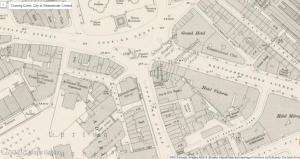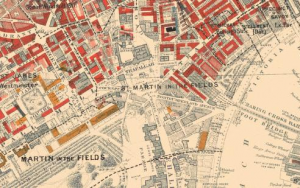
Charing Cross is the name of a T shaped intersection near Trafalgar Square in London. According to The Victorian Web, the area gets its name from the Queen Eleanor Memorial Cross located nearby, though it is not named after the cross itself. Apparently the word “Charing” comes from the Old English cierran, meaning to turn: it was meant to indicate to turn at the cross “from the Strand towards Westminster” (The Victorian Web). According to the Charles Booth poverty map, the surrounding area was a mixture of upper class, upper middle class, well-to-do middle class, and poor. Closest to the actual road labeled Charing Cross, however, there appears to be mostly shades of blue, indicating poor or very poor.

The high population of poor people in the area explains why when searching just “Charing Cross” (with no further criteria) on The Old Bailey, the search came up with 1835 results. Not all of these results described crimes that happened at Charing Cross, instead they might have been testimonies that involved Charing Cross in a manner unrelated to the crime. Many of the crimes that did actually occur at Charing Cross were murders of various degrees, theft, or deception (forgery). Crimes that would be typical in an area of poor people with nearby middle class homes.
When searching Charing Cross on British History Online, I found information on the architecture of buildings. One section explained that “the deep decline in the standards of London’s street architecture during the late nineteenth century is nowhere more evident than in Charing Cross Road. The southern half of the street is dominated by the ugly repetitions of Sandringham Buildings, multi-storey artisans’ dwellings with shops at ground-floor level, which extend along both sides of Charing Cross Road between Litchfield and Great Newport Streets” (BHO). These buildings were erected to provide for the rehousing of 2,000 of the laboring classes (BHO). This re-emphasizes the fact that Charing Cross was filled with the poor, lower classes.
In “A Lost Masterpiece” Charing Cross is the bus stop where the narrator completely loses their “little masterpiece” (Egerton). This masterpiece had been disrupted when the narrator saw a woman running to catch the omnibus. The narrator explained that this annoyed them because they “could not help wondering why she was in such a desperate hurry” (Egerton). The narrator apparently cannot relate to having to rush. When the bus stops at Charing Cross the narrator says “Of course, naturally! Here she comes, elbows out, umbrella waning!” (Egerton). Considering my research seems to indicate a high population of poorer people in the area, this scene seems to be speaking directly to the idea of class divide. Clearly referring to the woman who was rushing earlier for some unfathomable reason, the narrator’s statement “of course, naturally” indicates that it makes sense that a woman who was getting off at Charing Cross would be rushing. She would be of a lower class and not have the time to sit on an omnibus nursing the ingenious masterpiece forming in their mind. It has already been made clear that the narrator does not understand the need to rush, showing that they are probably of a higher class.
Work Cited
Booth, Charles. “Booth Poverty Map & Modern Map (Charles Booth Online Archive).” Booth Poverty Map & Modern Map (Charles Booth Online Archive). London School of Economics & Political Science, n.d. Web. 09 Sept. 2015.
Egerton, George [Mary Chavelita Dunne Bright]. “A Lost Masterpiece.” The Yellow Book 1 (Apr. 1894): 189-96.The Yellow Nineties Online. Ed. Dennis Denisoff and Lorraine Janzen Kooistra. Ryerson University, 2010. Web. 09 Sept. 2015.
http://www.victorianweb.org/art/architecture/barryem/4.html
“Shaftesbury Avenue and Charing Cross Road.” Survey of London: Volumes 33 and 34, St Anne Soho. Ed. F H W Sheppard. London: London County Council, 1966. 296-312. British History Online. Web. 8 September 2015.
“The Proceedings of the Old Bailey.” N.p., n.d. Web. 09 Sept. 2015
